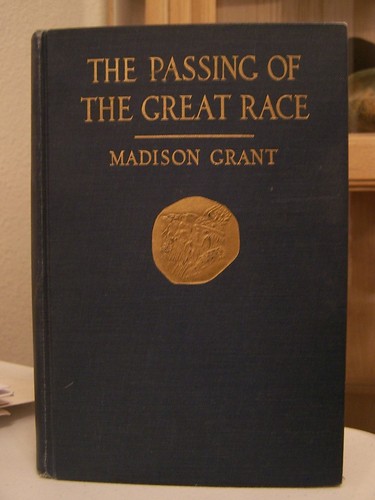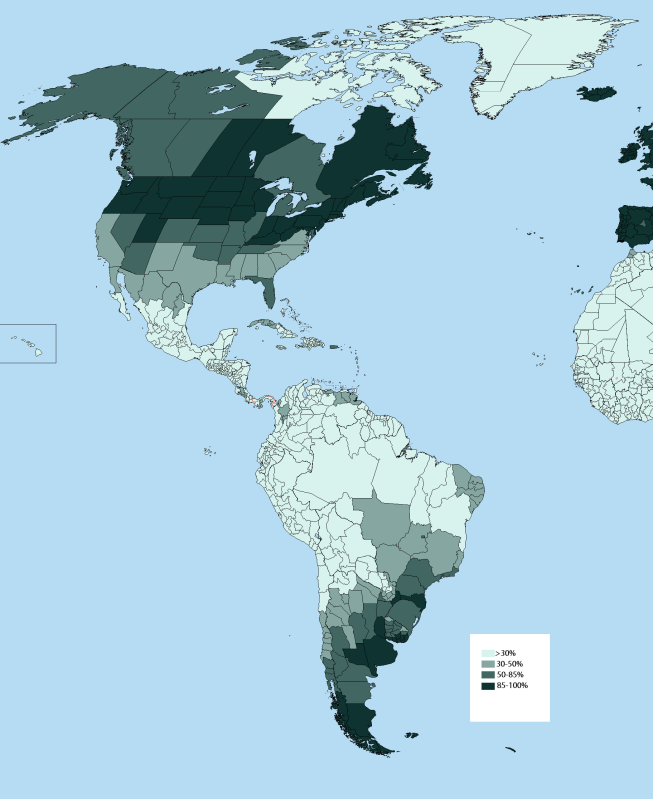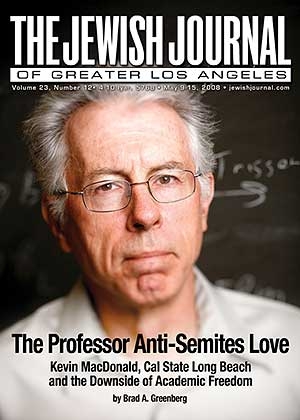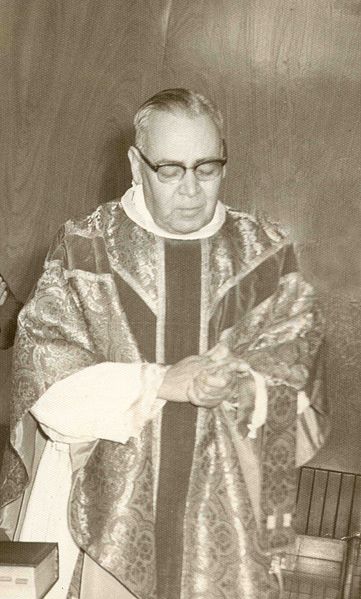The Brigade excerpts, chapter II
by Harold Covington
The Trouble Trio

No ellipsis
added between
unquoted paragraphs:
“Like we’re not marked already?” snorted Washburn. “I think Lear knows damned well who did Liddy King and that plug-ugly dyke Proudfoot. He gave me a funny look when he talked to me about your night of gainful employment at the store. It’s common knowledge we’re Steve’s closest friends, and Zack’s military record isn’t exactly a secret.”
“Yah, same with me. I think he knows, all right. He just can’t prove anything,” said Len Ekstrom.
“I don’t think he wants to prove anything,” said Hatfield. “What I don’t understand is why no FBI involvement? Why no mention in the media of the letters NVA I scrawled on the bedroom wall in dyke squaw blood?”
* * *
“Right on time. A good sign in a revolutionary.”
“How was the traffic on the bridge?” asked Hatfield. “We came down the scenic route, from Ilwaco,” replied the newcomer. “Homeland Security is starting to put closed-circuit TV cameras on bridges.”
“You know our names now, but all we know about you is you’re called Mr. Chips,” said Charlie. “Do we get code names too?”
“Eventually you’ll each have a whole collection of your own, yes,” said the Party’s man with a smile. “Mr. Chips isn’t so much a code name as it is a nickname. I used to be a schoolteacher up in Dundee, and I taught a kind of unofficial history course to certain selected white students after school, strictly extracurricular. The feds know who I am, and there’s no reason you shouldn’t. My name is Henry Morehouse, but back in the days when I had more hair, I ended up being called Red. You guys acted, on your own, and that impresses us. Zack has told me about the incident that took place here with the King woman and her beast of pleasure.”
“Uh, we gonna have to take some blood oath or something?” asked Ekstrom.
“No, not at this time,” said Morehouse. “Later the Army may find it expedient to formalize. For now, if you’re good men and true then an oath is unnecessary, and if you’re not, no oath will make you so. If I say you’re in, then you’re in.” Morehouse paused and took a sip of coffee. “The first question that I need to ask is the obvious one. Are all of you up for this? Do you fully understand just what the hell you’re doing? This isn’t a video game or a made-for-TV movie. This is the real thing. You see what’s going on in the Northwest, every time you turn on CNN. People are dying, and not just white people this time. The Beast is in a blind rage. It has been defied and it has been wounded, and it’s lashing out in all directions. You do understand that if you proceed, there is every chance that you men will end up either dead or living out the remainder of your lives in a federal prison, under conditions that don’t bear thinking about?”
“Mister, the way they’re hollering in the news media about racism and domestic terrorism, if we were even caught sitting here with you, we’d go to prison for the rest of our lives,” said Ekstrom. “We know this, and we’re still here.”
“Yeah, official paranoia is rampaging, all right,” replied Morehouse with a chuckle. “They’re starting to wake up to the fact that they didn’t get us all when they stormed into Coeur d’Alene last month, and some of us are still fighting. Fair enough. But before we get down to cases, I’d like each of you to tell me in your own words what has brought you here tonight.”
“I guess I’ll start,” said Hatfield. “I knew that time had to come, if any of us in this country had one spark of manhood left in us. We have tried everything else,” Hatfield went on grimly. “For generations we have dutifully trooped to the polls like sheep and voted in elections where we were given no meaningful choice, and where not one single candidate or party represented the white man’s racial interests. Nothing changed except the politicians grew more and more coarse and corrupt, more cynical and contemptible. We tried the internet and spent years tapping to one another on keyboards, because we bought into the idea that ‘education’ was the answer, and if we could just get the truth to people, then things would change. Well, education without action isn’t worth a bucket of warm spit. We got the truth to people, all right, and it turned out to be nothing but a bunch of noise that was simply ignored, because the internet was where it stayed. Nobody ever did anything except tap on keyboards. That was fine with the bosses. Tapping on keyboards was no threat to them, we just let off steam and nothing changed. It is now crystal clear to any white man with two brain cells to rub together that the only thing that will make these dogs in power hear the word no is the sound of gunfire.
“But I didn’t make up my mind finally until that night when I took care of Steve King’s problem for him,” Hatfield continued heavily. “I never realized just how damned good it would feel to strike back! It wasn’t like Iraq at all.”
“I know what you mean,” said Charlie Washburn with a smile. “For once, just once, the bad people didn’t win. I am just so damned sick and tired of bad people always winning all the time. But not this time. For once, just once, there was true justice and a good man and two good children will now have some kind of a chance together in life. A horrible deed committed by wicked perverts has been undone. The scales were balanced just a tiny bit back in the right direction. I feel it too, and it’s indescribable.
“But it’s more than that with me,” he went on carefully. “You know, Americans see a lot of movies and TV shows where some ordinary Joe like me is called upon to step up to the plate, so to speak, and be a hero in some way, usually fighting against the Arabs or Serbs or French or evil white racists or whoever the Jews’ main enemy of the moment is. Most of those flicks are just hokum, but in the past few months, ever since Coeur d’Alene, I’ve been feeling like that. Like I’ve gotten a call from destiny.”
“Things must change,” said Lennart Ekstrom slowly. “Every white man and woman in America knows it, deep down inside of themselves. This isn’t America anymore.”
“And that, Mr. Ekstrom, is what the white race has been waiting to hear from men like you for a hundred years,” said Morehouse with a nod. “You know that we were in a very similar situation, back before the Party was formed? The Old Man himself Came Home in 2002, but for years he simply sat all alone in a series of cracker box apartments or trailers or boarding houses, pounding on a computer that grew older and crankier as time passed. For years he looked for those out-of-state license plates to come over the hill, begging and pleading on his knees with his fellow white people to come to his side and help him, and for year after year, no one came. He asked only for a hundred good men, or women. One hundred people who were willing to place the future of their blood and their civilization over their own personal welfare. And for year after year, no one came.”
“And then what happened?” asked Ekstrom.
“Then they came,” replied Morehouse simply. “We refer to this among ourselves as The Awakening, and we still don’t understand it fully. Don’t get me wrong when I say this, because we’re not a religious movement, rather the reverse in fact. But the best and most comprehensible way that I can put this, is that it had to be some kind of divine intervention. God decided to give His most wonderful and yet wayward children one final break before He threw the white race onto the scrap heap of history. He reached into the hearts of one hundred people and moved them, changed them, so that they let the scales fall from their eyes and they knew they had to put something above their own well-being; that they had to live for something besides a job and a paycheck and a shopping spree at the mall. One day it just kind of began, and one hundred people stopped worrying about themselves and went out and began packing the moving van. The Old Man had his first hundred, and they became the nucleus of the Party that was formed when they came to the Homeland and were in place. Without that first hundred people, there could have been no Party, because it was they who set up the infrastructure and the safety net so the rest of the migrants would have something to Come Home to.”
“We’re going to need more than a hundred men now,” said Washburn gloomily.
“They will come,” said Morehouse with quiet confidence. “They came before. Damned late, but they came. Very well. Let’s get on with it.” He knocked back the rest of his coffee, put down the mug, and leaned forward to speak to them. “We are here to make history, gentlemen. We are here to plan and execute the first organized, armed insurrection against the United States of America since 1861.”
“I’m in,” said Hatfield.
“I’m in,” said Washburn.
“And I,” said Ekstrom.
“Gentlemen, you just swore your blood oath. Make sure you honor it all the days of your lives,” said Red softly.
“I look back at all the crap our people have put up with over the past century and I am still astonished that we never picked up a gun before,” said Washburn plaintively. “Why the hell has the white man never fought?”
“Oh, God,” said Morehouse with a sigh. “Some of us have spent our entire lifetimes studying that one simple question, Charlie, and I have to say we’re no closer to an answer than we were at the beginning. There are a few standard, canned answers, of course. Up until the past couple of decades, most white people simply had it too good. Life was just too damned sweet, and all the bullshit caused by liberal democracy and political correctness didn’t seem to be really life-threatening, just more and more annoying as time wore on. When men are merely annoyed, they write letters to the editor, or phone a radio talk show, or bitch and gripe drunkenly in bars about how the world is going to hell. They don’t pick up a rifle or start making bombs in their basement. And of course, up until about twenty years ago, if things got too bad where you were living, then you could just up stakes and move to the suburbs, or some other state that was a little whiter.
“Liberals are always the first to flee from the messes they make. Usually, they’re the only ones who can afford to do so. Anyway, liberalism and political correctness have gone beyond the merely annoying phase for a long time now. Things have been getting colder and crueler for white people. Medicare. The drawbacks of our wonderful democracy have become quite apparent to those of us who find ourselves living in the northernmost province of Mexico. They can’t sweep all the problems under the rug anymore. They’re too visible and obvious, and no one has any money left to run to the suburbs.”
“But that still hasn’t produced anything other than an army of white people hollering on talk radio and then trooping in to the polls on election day to vote Republican,” complained Ekstrom. “What the hell was wrong with us back in the 60s and 70s? Or even earlier? Why didn’t we fight?”
“Perhaps the more pertinent question, Len, would be why are we fighting now?” asked Morehouse. But it’s more complicated than that. White American males are still capable of being physically brave, sure they are. They prove it every day on the battlefield. Every week you can see some story on the tube about a white cop who faces down a pack of gang-bangers or a white fireman who pulls kids out of a burning building, and then you get these extreme sports kooks who jump out of airplanes with snowboards and try to surf down Mount Everest, or snorkel butt naked in a school of sharks, that kind of nonsense.”
“God knows I saw enough Aryan heroism every day in Iraq,” said Hatfield. “White men will still be as brave as lions, granted, but only for the Jews or for their money, Red. When it comes to standing up and fighting for ourselves, against the Jews and the government that’s tyrannizing us, all of a sudden we wuss out.”
“Mmmmm, here’s where it gets complex, Zack,” said Red contemplatively. What we can’t seem to do is to be brave on our own, for our own interests, without the Jewish seal of approval. We have developed a poisonous symbiosis with the system. We can be brave in a structured environment, so long as it is an officially approved form of courage.
You might say the Jew has succeeded in domesticating the Aryan. We can be brave and good dogs so long as we hear the reassuring sound of our master’s voice and get the occasional doggie treat from his hands, but we can’t be lone wolves anymore. We didn’t fight, Charlie, up until now, because for a century or so we have no longer been wolves, but dogs. The Jew domesticated us. But now we must hear the call of the wild again. We have to find that spirit of the wolf once more within us, and bite the hand that feeds us. And I suppose I’d better abandon that simile before I stretch it into a pretzel. But you get what I’m saying?”
“Yeah, I do,” said Zack with a sigh. “And that poisonous symbiosis between the American white male and the system is still very much with us, an ingrained part of us. How many guys are going to be able to break out of it? Those are going to be pretty rare birds.”
“Well, maybe not so rare,” said Red with a smile and a swirl of smoke. “Once that first hundred stepped forward, it wasn’t so hard for others to do so, because more and more, when they came here they found a crowd to hide in. It was getting that first hundred to go first that was the real bitch. We will be the tiny lion against the enormous snake, but the serpent is old and sick and dying, poisoned with its own crapulence.”
“The movement has always had to deal with this defeatist and paranoid belief that if we ever really tried anything, the might of the Army and the Marines would simply crush us,” said Hatfield.
“You would think that maintaining the territorial integrity of the United States would be the régime’s first priority, but it won’t be,” agreed Morehouse. “With the growing world fuel shortage, oil is frankly more important than land, and will become more so. After all, the Northwest has no oil, other than Alaska, which is a separate problem. The Army Council’s strategic assessment is that initially, at least, there will be only a small actual military commitment against us, if any. They won’t take us seriously. Wishful thinking on their part: they desperately won’t want to take us seriously. The idea that white boys would actually revolt against them boggles their minds too much. They’re not going to be sending B-52s to bomb Seattle or landing the Third Marine Division in Astoria. What would that accomplish against small bands of guerrillas who will simply melt away in the face of overwhelming force, and then strike where the underbelly is soft? I think they’ve learned at least that much in Iraq and Iran. It won’t be that type of war.
“No, they’ll try to treat us as a crime problem at first,” Morehouse went on, the three of them leaning forward intently to listen. “Our enemies on the ground will consist of a hodge-podge of local police, National Guard reservists, FBI and BATFE, Homeland Security and other enemy paramilitaries, and eventually probably some SWAT-type special units. Of course, ideally speaking, it should never come to a full-blown shootout. We live light, we move light, we hit hard, and then we vanish before they can bring their superior force to bear. Classic guerrilla tactics.”
“So how many men do you think we will need in the NVA to get the job done?” asked Ekstrom again.
Morehouse puffed his pipe meditatively. “We should be able effectively to terminate federal control over three Northwestern states and maybe more territory as well, if we can maintain a force in the field of approximately one thousand men.”
“Overthrow the United States government with a thousand men?” demanded Washburn in skeptical amazement. “Bullshit!”
“I didn’t say overthrow the United States government,” Morehouse corrected him. “I said effectively terminate federal control and authority in three large Northwestern states, which is not the same thing.”
“How?” asked Ekstrom.
“By hitting the enemy hard and often, in teams or crews of two to five or six people max. Let’s assume an average of five Volunteers per squad or crew. Our thousand effectives will make up two hundred such crews. Assume half of them are involved in support duties, supply, intelligence, medical services, propaganda, whatnot. That’s one hundred combat teams of five guys each remaining, who are actually pulling triggers and making things go boom. Imagine each of those crews striking the enemy on an average of once per day, all across the Northwest. Remember, one of the main reasons we migrated and we’re restricting our campaign to this corner of the country is to reduce the problem to manageable proportions. Let’s assume an average of a single dead enemy of one kind or another per attack. That’s 100 people per day being killed in one three-state area, with concomitant damage to enemy property, infrastructure, and damage to his morale, his public image, and thereby his capacity to govern. Their armies are designed to fight Star Wars, but we won’t be fighting Star Wars. We’ll be fighting Godfather style.” Morehouse knocked out his pipe onto the concrete floor, and then went on.
“In Vietnam, in Iraq, in Iran and Afghanistan, ZOG had every gadget and deadly toy human ingenuity could devise, computerized and covered with bright shiny lights. But they never found a way to beat the little barefoot brown man, dressed in rags and armed with an AK- 47 and a couple of magazines of ammo, and a heart that would never surrender. The human heart and the human spirit can beat their machines, gentlemen. The human heart and the human spirit can beat their money. The human heart can beat their lying media.”
“That’s if we can find the kind of political soldiers necessary for that kind of warfare,” Hatfield reminded them. “The guys with the cool head and the iron nerve and the ice water in their veins.”
“You got it,” agreed Morehouse with a nod. “I can outline for you a structure for a revolutionary armed force. I cannot turn mere white males into white men once again, men that our ancestors would have recognized. That we must somehow do for ourselves, by finding within ourselves that last dying spark of pride and honor and courage that has always distinguished us for thousands of years.”
“You think these bastards will give in no matter how many people we kill?” asked Washburn. “Iraq and Afghanistan are very far away, something people read about over their morning coffee or watch on CNN. We will be striking at the very core of their power, right here on what they consider their home turf. Can they psychologically bring themselves to admit defeat even if we beat them?”
“This is another reason why we are not being so foolish as to try this in all 50 states. What we’re going to be doing, Charlie, is we’re going to be fighting a classical colonial war,” Morehouse told him. “There are rules for fighting a successful colonial war, and they have come into play dozens of times over the last century, from Ireland to Africa. We’re not trying to take their whole loaf from ZOG. Of course, they’d resist that to the death. Such a guerrilla war across all of America would last for generations, and anything we could salvage after such a conflict probably wouldn’t be worth living in anyway. Nor could we win it. For one thing, we’d have to slaughter over one hundred million non-whites, or drive them back south of the Rio Grande in the most massive refugee wave ever seen, and that simply isn’t feasible with what we have or what we are likely to get.
“With our thousand or so people—and by the way, there will almost certainly be more than that as our insurgency grows—anyway, what we can do is to make these three states of Washington, Oregon, and Idaho and maybe parts of Montana and northern California completely ungovernable. We can stop the United States from reaping any profit or income from this territory, and we can turn it into one gigantic black hole sucking in men, resources, time, effort, and above all money. Gentlemen, there is a truth to fighting and winning a colonial war that I want all of you to burn into your brains, because it is the key to our victory. In a colonial war, the generals never surrender! The accountants surrender! What we have to do is to confront the United States with a situation where as bad and as humiliating as it will be to let the Northwest go and let white people have their own country, the continuation of the guerrilla war is no longer an option for them. We can win this, comrades,” concluded Morehouse decisively. “We can beat the God Almighty United States of America, kick their stinking rotten asses right out of here, and take this land for ourselves and our children. But only if we have the stomach for it.”
There was a long moment of silence. “Let’s get started, then,” said Hatfield.
“Right,” said Morehouse, filling his pipe again. “Okay, you’ve already got the basics here. You’ve got three men. In this room you’ve already got your first Trouble Trio.”
“Say what?” asked Charlie.
“The basic building block of the NVA company,” said Morehouse. “A three-man team. When we were planning all this out, studying and analyzing how previous successful revolutionary movements worked in Western political and social environments similar to ours, we came up with a kind of hybrid anatomy combining the IRA and the Cosa Nostra, two highly successful subversive outfits who to this day have never been completely repressed by their governments. You’d be amazed how much hell three men can raise in a society this complex, this racially volatile and unstable.
“Go ahead,” Hatfield urged him.
Morehouse lit his pipe again. “You start with three people as I said, all of whom must have the requisite qualities of courage, resourcefulness, loyalty, and fanatic dedication. That’s the hard part, finding the right men and women for this. Each of these threes will be the nucleus of a company. I know it sounds ridiculous to call three people a company, but there will be more of you, and what we want is a structure that we can maintain right up until the end, when we will make the transformation from a guerrilla insurgency to become a proper national army. During our initial underground phase, the NVA is not an ordinary army where units are supposed to have some kind of set strength or function. We are as fluid as a lava lamp, always changing shape and bobbing around. Each company needs to be free floating, capable of conducting operations indefinitely on its own, even if it is totally cut off from the rest of the movement, and eventually regenerating itself and growing, adding more cells, like an amoeba.
“Each company will be part of a larger unit called a brigade,” Mr. Chips continued. “The next unit up from a company in most armies is actually the battalion, but we’re not going to create any of those until necessary and until we’ve got the bodies. The brigade will be the main operational combat unit of the Northwest Volunteer Army, responsible for taking on ZOG within a roughly defined operational area. Each brigade will report to and be directed by the Army Council in the person of one or more political officers.”
“So the political officer actually commands the brigade?” asked Charlie.
“No. He’s strictly a liaison who acts as a communications conduit between the brigade commander and the central organization.”
“Got it,” said Charlie. “I’m a state forestry employee and I have an official truck and uniform and ID, so I can be seen pretty much anywhere and have a good reason for being there that won’t cause comment.”
“That’s ideal,” said Morehouse with a nod. “Now, one of the first things you will need to do is recruit more Volunteers. This will be the most potentially dangerous of all the things you do. Make a mistake and try to bring in the wrong man, and you’ve compromised the whole company. Make a bigger mistake and actually bring the wrong man in, and you will either die or spend the rest of your lives being sodomized by niggers in the prison shower. Your first duty will of course be to clear this North Shore area of all enemy forces and non-whites.”
“Define enemy forces,” requested Hatfield.
“Anyone who is part of the federal apparatus of control and enforcement, or who assists in maintaining the Zionist occupation, or who gives aid and comfort to the régime,” Morehouse explained. “Military personnel, of course. FBI and Homeland Security agents, obviously. Certain local police but not all; that’s a special problem I’ll go over with you later. Some of the cops will be on our side, or at least willing to stand aside and let us get on with it. State and federal judges and anyone to do with the court system, and all lawyers. Federal bureaucrats of any kind, but especially anyone to do with the IRS or revenue collection. One of the keystones of our strategy is that from now on, not one more dime we can prevent goes to Washington, D.C. from the Pacific Northwest. Elements in the media and the civilian population who actively support the régime or propagandize for it. And of course, anyone with skin the color of shit is henceforth persona non grata in the Northwest. Believe me, Zack, you won’t lack for targets. Basically, your job is to make sure that from Beaverton on down the river to the sea, ZOG’s writ doesn’t run anymore.”
“That’s a mighty big stretch of territory,” commented Ekstrom with a frown.
“Yes, but the potential is immense,” replied Morehouse with a smile. “I don’t know if it’s hit you guys yet, but you’re sitting right in the middle of perfect guerrilla country here. Huge expanses of heavy forest, mountains and ravines where you could hide an army. The whole area a backwater that the feds won’t want to expend much on in the way of effort or manpower, because their main fight will be in the cities.”

http://northwestfront.org/

 In Mexico the proportion is larger, but the unmixed whites number less than twenty per cent of the whole, the others being Indians pure or mixed. These latter are the “greasers” of the American frontiersman.
In Mexico the proportion is larger, but the unmixed whites number less than twenty per cent of the whole, the others being Indians pure or mixed. These latter are the “greasers” of the American frontiersman. Concentration of whites in the American Continent
Concentration of whites in the American Continent As to what the future mixture will be it is evident that in large sections of the country the native American will entirely disappear. He will not intermarry with inferior races and he cannot compete in the sweat-shop and in the street trench with the newcomers. Large cities from the days of Rome, Alexandria, and Byzantium have always been gathering points of diverse races, but New York is becoming a cloaca gentium which will produce many amazing racial hybrids and some ethnic horrors that will be beyond the powers of future anthropologists to unravel.
As to what the future mixture will be it is evident that in large sections of the country the native American will entirely disappear. He will not intermarry with inferior races and he cannot compete in the sweat-shop and in the street trench with the newcomers. Large cities from the days of Rome, Alexandria, and Byzantium have always been gathering points of diverse races, but New York is becoming a cloaca gentium which will produce many amazing racial hybrids and some ethnic horrors that will be beyond the powers of future anthropologists to unravel. 



